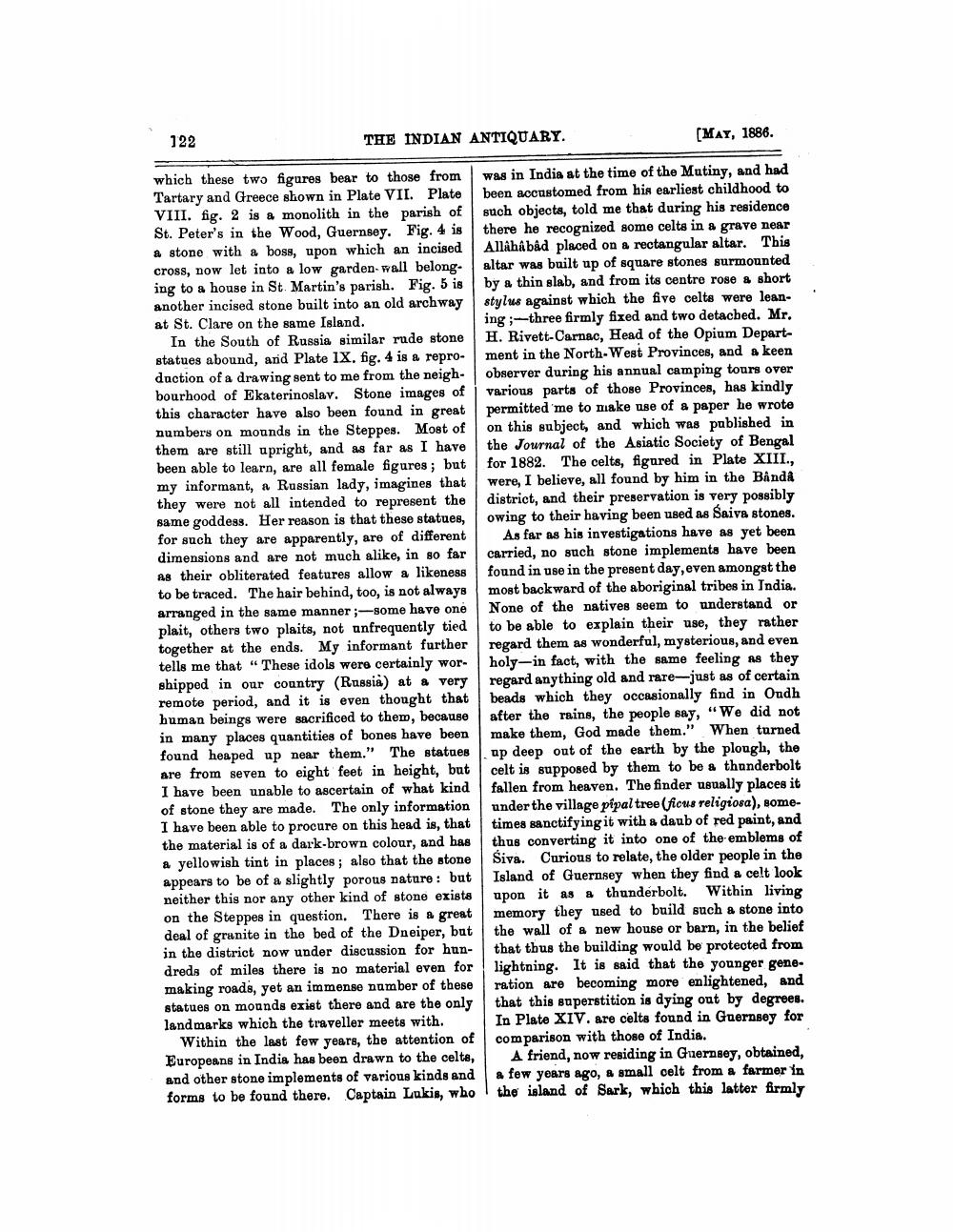________________
122
THE INDIAN ANTIQUARY.
which these two figures bear to those from Tartary and Greece shown in Plate VII. Plate VIII. fig. 2 is a monolith in the parish of St. Peter's in the Wood, Guernsey. Fig. 4 is a stone with a boss, upon which an incised cross, now let into a low garden-wall belonging to a house in St. Martin's parish. Fig. 5 is another incised stone built into an old archway at St. Clare on the same Island.
In the South of Russia similar rude stone statues abound, and Plate IX. fig. 4 is a reproduction of a drawing sent to me from the neighbourhood of Ekaterinoslav. Stone images of this character have also been found in great numbers on mounds in the Steppes. Most of them are still upright, and as far as I have been able to learn, are all female figures; but my informant, a Russian lady, imagines that they were not all intended to represent the same goddess. Her reason is that these statues, for such they are apparently, are of different dimensions and are not much alike, in so far as their obliterated features allow a likeness to be traced. The hair behind, too, is not always arranged in the same manner;-some have one plait, others two plaits, not unfrequently tied together at the ends. My informant further tells me that "These idols were certainly worshipped in our country (Russia) at a very remote period, and it is even thought that human beings were sacrificed to them, because in many places quantities of bones have been found heaped up near them." The statues are from seven to eight feet in height, but I have been unable to ascertain of what kind of stone they are made. The only information I have been able to procure on this head is, that the material is of a dark-brown colour, and has a yellowish tint in places; also that the stone appears to be of a slightly porous nature: but neither this nor any other kind of stone exists on the Steppes in question. There is a great deal of granite in the bed of the Dneiper, but in the district now under discussion for hundreds of miles there is no material even for making roads, yet an immense number of these statues on mounds exist there and are the only landmarks which the traveller meets with.
[MAY, 1886.
was in India at the time of the Mutiny, and had been accustomed from his earliest childhood to such objects, told me that during his residence there he recognized some celts in a grave near Allahâbâd placed on a rectangular altar. This altar was built up of square stones surmounted by a thin slab, and from its centre rose a short stylus against which the five celts were leaning;-three firmly fixed and two detached. Mr. H. Rivett-Carnac, Head of the Opium Department in the North-West Provinces, and a keen observer during his annual camping tours over various parts of those Provinces, has kindly permitted me to make use of a paper he wrote on this subject, and which was published in the Journal of the Asiatic Society of Bengal for 1882. The celts, figured in Plate XIII., were, I believe, all found by him in the Bånda district, and their preservation is very possibly owing to their having been used as Saiva stones.
Within the last few years, the attention of Europeans in India has been drawn to the celts, and other stone implements of various kinds and forms to be found there. Captain Lukis, who
As far as his investigations have as yet been carried, no such stone implements have been found in use in the present day, even amongst the most backward of the aboriginal tribes in India. None of the natives seem to understand or to be able to explain their use, they rather regard them as wonderful, mysterious, and even holy-in fact, with the same feeling as they regard anything old and rare-just as of certain beads which they occasionally find in Oudh after the rains, the people say, "We did not make them, God made them." When turned up deep out of the earth by the plough, the celt is supposed by them to be a thunderbolt fallen from heaven. The finder usually places it under the village pipal tree (ficus religiosa), sometimes sanctifying it with a daub of red paint, and thus converting it into one of the emblems of Śiva. Curious to relate, the older people in the Island of Guernsey when they find a celt look upon it as a thunderbolt. Within living memory they used to build such a stone into the wall of a new house or barn, in the belief that thus the building would be protected from lightning. It is said that the younger generation are becoming more enlightened, and that this superstition is dying out by degrees. In Plate XIV. are celts found in Guernsey for comparison with those of India.
A friend, now residing in Guernsey, obtained, a few years ago, a small celt from a farmer in the island of Sark, which this latter firmly




